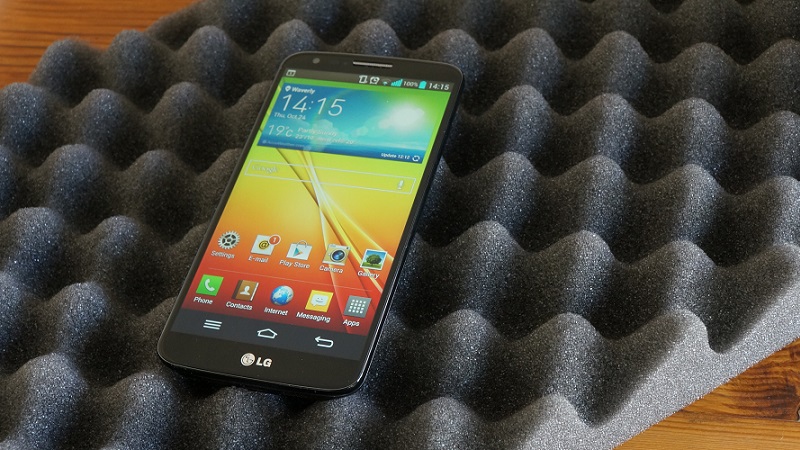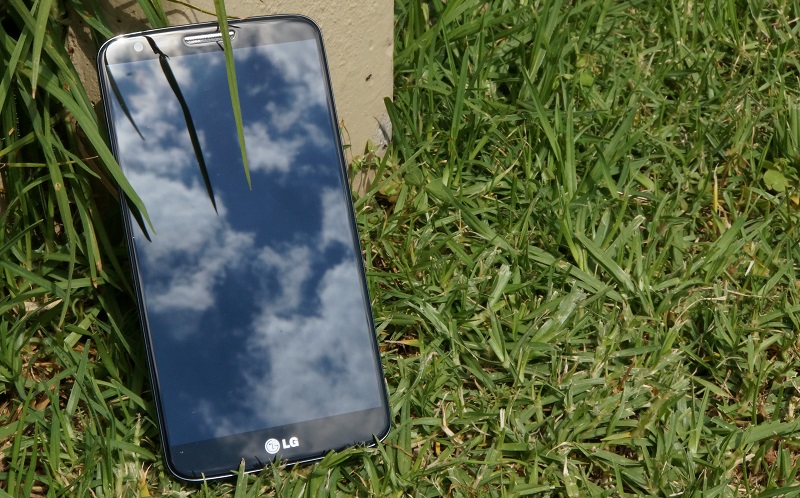The LG G2 is the latest flagship smartphone from the other Korean tech giant. It’s received a lot of attention since it was first announced in August, and we’ve been excited to get out hands on one to see if it lives up to the promise that we saw in the Optimus G Pro we tested earlier this year.
Design
The G2 is beautiful. In fact it may be one of the most beautiful smartphones ever made. The front is dominated by a 5.2 inch, full HD display with bezels so thin it beggars belief. The front of the phone lacks physical buttons, leaving the display to dominate – but as with all stock Android devices there are on-screen Home, Back and Menu buttons.
The back of the G2 is clad in a rigid, patterned plastic, with rounded edges that lets you cradle it in your hand. The power and volume buttons have been banished from their usual spot along the left or right edge, and LG has relocated them to the back of the phone – right underneath the camera. Here, they fall to finger more naturally, especially when holding the device in one hand. The bottom of the G2 houses the speakers, a microUSB charging port, and a headphone jack. Meanwhile the SIM tray is on the side of the phone, something introduced by Apple on the iPhones.
Hardware
All the components you’d expect in a high-end Android are present in the G2. There’s a Snapdragon 800 processor, paired to 2GB of RAM. Storage options are either 16 or 32GB – and that’s what you’re stuck with, since there’s no microSD card expansion slot. The best of every wireless connectivity standard is included, with LTE, dual-band 802.11ac WiFi and Bluetooth 4.0 all available as standard on the G2. This puts it on par, specs-wise, with the Sony Xperia Z1 and Galaxy S4 Active, which have nearly identical hardware specifications.
Photographers can also rejoice: the G2 sees a second great camera option to the Android platform, but more on its 13Mp shooter in the camera section.
Software
The G2 runs on Android 4.2.2, which might not be the very latest, but is still very good. It’s just a shame that it doesn’t run 4.3, which offers some long-term benefits for storage management and the ability to use Bluetooth 4.0 natively in Android. Although, this will be moot if LG can upgrade the G2 straight to Android 4.4 (KitKat) when it arrives later in the year.
Generally speaking, Android enhancements from phone manufacturers tend to fall into two camps: useful or completely useless gimmick. With the G2, LG has more of the former and far less of the latter, especially compared to some of its competition. Two of those include:
- KnockON – With the G2’s power button having been moved to the rear you would need to pick up the device to quickly turn it on. KnockON lets you tap the screen twice to turn it on or off, which saves a surprising amount of time in real-world usage.
- Guest Mode – Using a different unlock pattern opens a second home screen layout with access to only the apps that you define. Great for giving your phone to kids who only need access to games, or to friends who want to look at the phone but don’t need to see your social and messaging apps.
Display
The 5.2 inch 1080P display is by far the most noticable feature of the LG G2. It’s a fantastic LCD, using IPS+ tech to offer excellent colour reproduction and superb brightness. It’s only weakness is direct sunlight, where glare can become an issue. Even though it is larger than its contemporaries, such as the Samsung Galaxy S4 and the Sony Xperia Z1, the LG G2 manages to feel more compact and easy to use. This is largely due to the minuscule bezels around the display – and we can honestly say that it’s about time large phones shrunk their sides.
Camera
It might share specifications with its Korean competition, but the 13Mp sensor in the G2 includes Optical Image Stabilisation (OIS). This means both photos and videos are clearer as a result of mechanical stabilisation, and even low-light photos come out beautifully. And photos also look more natural, since the OIS the G2 allows it to capture images in low light without needing to use a flash.
Battery Life
While the display is the most noticeable feature of the G2, the battery is by far the most impressive. A large 3 000mAh battery is complemented by tons of battery- and time-saving technology to help the G2 last longer than its competition. In fact, after taking our review unit off charge at 7AM it still had 20% battery left at 11PM – not bad, considering a hard day’s use and four stints of GPS navigation.
The G2 uses a Silicon anode (SiO+) battery which is essentially an enhancement of the Lithium ion batteries used in other smartphones and laptops. LG says that the technology allows the battery a 6% improvement in capacity – a move that’s paid off considering the fact that it has managed to fit a 3 000mAh battery into a smartphone as thin as the G2. LG also used its step-designed battery, which allows for more battery to be built into the same amount of space in a curved design like the G2 has.
The battery isn’t the only piece of tech that helps the G2’s power economy, though. LG has included a GRAM (graphics RAM) module, which is a small chunk of memory that is used by the display to save battery power. It does this by understanding when static content (like your home screen) is being displayed, and then an image in GRAM is used to draw content on the screen, rather than the display refreshing constantly. This allows the processor to go into a lower power state and sip even less power.
But there’s more: the Snapdragon chip includes a piece of technology Qualcomm calls Quick Charge 2.0. As the name suggests, this allows the phone to charge itself quicker than normal by optimising the flow of electricity into the battery, over time. Qualcomm claims that the battery will go from 0-25% in just 12 minutes, with an addition 50% should fill up in just 30 minutes. In practise this allows G2 users to get a decent amount of power when they only have a short amount of time. There is a drawback, though: Quick Charge can can only be used with the official LG power supply, and not any old microUSB charger.
Conclusion
The G2 is as close to perfection as an Android smartphone has ever come. The design and build are of a quality seldom seen from Android OEMs, and the internal hardware is the best on offer in almost each category. There are of course problems with it, but they are more in the realm of mild irritation than they are deal breakers.
This is the first Android phone in a long time that I haven’t wanted to give back after reviewing. I could happily live with it being my primary phone for the foreseeable future.
Design: 5/5
Performance: 5/5
Battery life: 5/5
Value for Money: 4/5
Display: 4/5
Interface: 4/5
Overall: 5/5
Detail
Price: R7 299
Display: Processor: 2.26 GHz Qualcomm Snapdragon 800 (MSM8974)
Memory: 2GB RAM
Storage: 16/32GB non-expandable storage
Camera: 13-megapixel rear with OIS, 2.1-megapixel Full HD front
Networking: LTE, 3G, Bluetooth 4.0 LE, Dual-band 802.11ac wireless
Other: SiO+ Battery, Qualcomm Quick Charge 2.0



